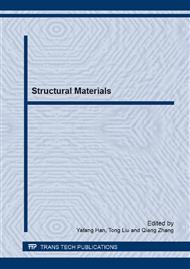p.593
p.598
p.604
p.608
p.613
p.617
p.621
p.627
p.632
Preparation of Al2O3 Based Nano-Micro Composite Gradient Self-Lubricating Ceramic Tool Materials
Abstract:
Aiming at the low mechanical property of existing self-lubricating ceramic cutting tool material, a new Al2O3 based nanomicro composite gradient self-lubricating ceramic tool material was developed by applying the design concept of nanomicro composite. The self-lubricating ceramics was composed of ceramic matrix and self-lubricating component, and was prepared by hot pressing technology at a hot-pressing temperature of 1650°C, pressure of 30MPa, and duration of 15min. The model of gradient ceramic tool material is symmetrical composition distribution, and the compositional distribution n and layer number are 1.8 and 7, respectively. The result shows that the interfaces between layers are bonded well and no cracks or defects can be observed. Compare with the homogeneous material, the flexural strength, hardness and fracture toughness of Al2O3 based graded material increase by 74%, 5.2% and 3.9%, respectively.
Info:
Periodical:
Pages:
613-616
Citation:
Online since:
April 2014
Authors:
Price:
Сopyright:
© 2014 Trans Tech Publications Ltd. All Rights Reserved
Share:
Citation:


